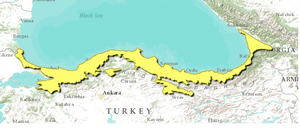Euxine-Colchic deciduous forests
The Euxine-Colchic deciduous forests ecoregion, in the Temperate broadleaf and mixed forests Biome, is located along the southern shore of the Black Sea.[1] The ecoregion extends along the thin coastal strip from the southeastern corner of Bulgaria in the west, to Georgia in the east, across the northern coast of Turkey, where it wraps around the eastern end of the Black Sea.
| Euxine-Colchic deciduous forests | |
|---|---|
 An Euxine forest in Strandzha Nature Park, southern-eastern Bulgaria | |
 Euxine-Colchic deciduous forests ecoregion along the southern coast of Black Sea, shown in yellow. | |
| Ecology | |
| Biome | Temperate broadleaf and mixed forests |
| Geography | |
| Area | 74,330 km2 (28,700 sq mi) |
| Countries | Bulgaria, Georgia and Turkey |
Sub-regions
The ecoregion is divided into two sub-regions, chiefly based on the amount of precipitation.
The understory of evergreen mesomorphic broadleaf shrubs is characteristic for both sub-regions. Notable species in the understory include various rhododendrons such as Pontic rhododendron (Rhododendron ponticum); Black Sea holly (Ilex colchica), cherry laurel (Laurocerasus officinalis), Caucasus (Buxus colchica) and common box (Buxus sempervirens), Caucasian whortleberry (Vaccinium arctostaphylos), etc. From a European perspective, the majority of these count as relict species from the Tertiary period.

Colchian forests
The Colchic or Colchian forests are found around the southeast corner of the Black Sea in Turkey and Georgia in and around the Machakhela National Park. The Colchian forests are mixed, with deciduous Black Alder (Alnus glutinosa), hornbeam (Carpinus betulus and C. orientalis), Oriental Beech (Fagus orientalis), and Sweet Chestnut (Castanea sativa), together with evergreen Nordmann Fir (Abies nordmanniana, the tallest tree in Europe at 78m), Caucasian Spruce (Picea orientalis) and Scots Pine (Pinus sylvestris). The Colchic region has high rainfall, averaging 1,500-2,500 mm annually, with a maximum in excess of 4,000 mm, and is home to some of Europe's temperate rain forests.
Euxinic forests
The drier Euxine or Euxinic forests lie west of the Melet River, which meets the Black Sea in the city of Ordu, and extend across the Bosporus along the Black Sea coast of European Turkey to Bulgaria. The Euxine forests receive an average of 1,000 to 1,500 mm precipitation annually. The Bulgarian part of the ecoregion lies within Strandzha Nature Park, where it borders on and transitions into the Balkan mixed forests ecoregion.
Rare habitat types include coastal sand dunes and peatlands.
Pine processionary moth is one of the threats.[2]
See also
- Forests of Turkey
- Northern Anatolia—Black Sea Region — of Asian Turkey.
- Machakhela National Park
- Mtirala National Park
- Kintrishi Protected Landscape
References
- "Euxine-Colchic broadleaf forests | Ecoregions | WWF". World Wildlife Fund. Retrieved 2019-05-31.
- "Gladiator bug to protect Istanbul's forests". DailySabah. Retrieved 2019-10-04.
External links
| Wikimedia Commons has media related to Euxine-Colchic deciduous forests. |
- "Euxine-Colchic deciduous forests". Terrestrial Ecoregions. World Wildlife Fund.